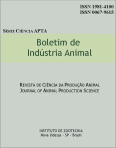Average daily gain and reactivity in Caracu young bulls
Keywords:
beef cattle, performance test, temperamentAbstract
Studies have shown associations between temperament traits and productivity on cattle industry, some results indicate that animals which adapt easily are less agitated, therefore there will be fewer losses in carcass due to the low incidence of hematomas and higher weight gain. The objective of this study was to associate the average daily gain in Caracu animals, subject to performance test (PT), with reactivity measured by flight speed test. The average daily gain was divided in three classes, considering 0.5 standard deviation below and above the average. The average gain classes 1, 2 and 3 was 1158.55 ± 89.48, 957.14 ± 54.77, 620.88 ± 127.41 g/day, respectively. The flight speed test (FS) measures how long the animal takes to cover a known distance after the release of the squeeze chute. Faster animals were considered more reactive. The study was performed at Centro APTA Bovinos de Corte from Instituto de Zootecnia-Sertãozinho, SP, in which were used 109 flight speed records, of 56 animals, obtained in the beginning and at the end of PT. Data were analyzed using the PROC MIXED (SAS 9.3). The model of analyses included the fixed effects of average daily gain classes (1, 2 and 3) and measures (1 and 2), besides the random-effects of animal and residue. The interaction classes measures, even as age as covariate, were excluded from the initial model, because they didn€™t show significance at level of 5%. Significant differences weren€™t observed (P>0.05) on reactivity of animals for the various average daily gain classes, evidencing that there was no relationship between performance and temperament in the animals evaluated. As in the present work, others studies performed in Centro APTA Bovinos de Corte, with Nelore animals also didn€™t find correlations between average daily gain and the flight speed test. The reactivity in Caracu steers measured in the beginning and at the end of PT was significantly (P<0.01) different. Whereas at the second measurement, the animals were slower to cross the distance stipulated. This fact was expected, because at the end of the test animals were habituated to handling and so less reactive. The results of this study indicate that there is no relationship between temperament and weigh gain on the animals evaluated. Caracu animals adapt easily to weighing handling.Downloads
Downloads
Published
Issue
Section
License
Os autores não serão remunerados pela publicação de trabalhos, pois devem abrir mão de seus direitos autorais em favor deste periódico. Por outro lado, os autores ficam autorizados a publicar seus artigos, simultaneamente, em repositórios da instituição de sua origem, desde que citada a fonte da publicação original seja Boletim de Indústria Animal. A revista se reserva o direito de efetuar, nos originais, alterações de ordem normativa, ortográfica e gramatical, com vistas a manter o padrão culto da língua e a credibilidade do veículo. Respeitará, no entanto, o estilo de escrever dos autores. Alterações, correções ou sugestões de ordem conceitual serão encaminhadas aos autores, quando necessário. Nesses casos, os artigos, depois de adequados, deverão ser submetidos a nova apreciação. As opiniões emitidas pelos autores dos artigos são de sua exclusiva responsabilidade. Todo o conteúdo deste periódico, exceto onde está identificado, está licenciado sob a Licença Creative Commons Attribution (CC-BY-NC). A condição BY implica que os licenciados podem copiar, distribuir, exibir e executar a obra e fazer trabalhos derivados com base em que só se dão o autor ou licenciante os créditos na forma especificada por estes. A cláusula NC significa que os licenciados podem copiar, distribuir, exibir e executar a obra e fazer trabalhos derivados com base apenas para fins não comerciais.













